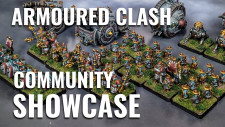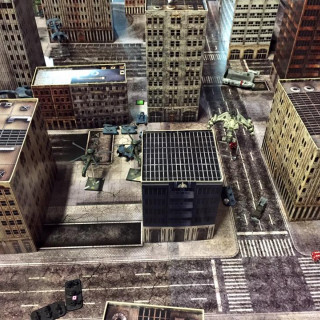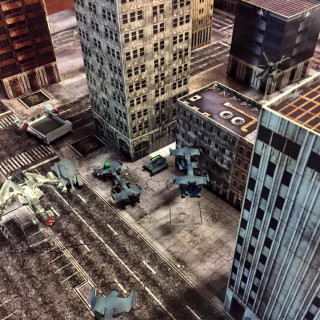Dropzone Commander
Review: A solid, balanced, fun time! Join the Reconquest!
Caveat: This is a review based on version 1.1 of the game, I haven't played any games with the Beta rules for v2.0 which is due to be released later this year (at the time of writing this)
I'm going to go through a brief summary of the background and then my views on the game are set below that.
The Background
Dropzone Commander is a 10mm army scale game set in the 27th century, 200 years after Earth and several of humanities best colony worlds were invaded by a parasitic alien race known as the Scourge. A year before the invasion a warning of impending doom was received from a mysterious White Sphere which crashed to earth and offered to save humanity if they fled to the Vega system. Those that followed the warning and fled engaged in a large fleet battle which crippled the loyalist fleet. The next day, the Scourge attacked and conquered all of the Core Worlds simultaneously. The remaining loyalists who managed to escape the invasion fled to the frontier colonies, which remained free from attack and appeared unknown to the Scourge. The codes for the FTL nodes were changed so that no other ships could follow and find the location of the colonies. The Colonies formed the United Colonies of Mankind (UCM) and set about a 200 year endeavour to build up a military force strong enough to retake the core worlds. The game is set during the UCM's Reconquest campaign of the Core worlds.
Those that fled with the White Sphere formed the Post Human Republic. They were never seen until shortly before the Reconquest Campaign was about to be launched. A PHR ship appeared in the UCM capital system and sought an audience with the government leaders. Their people were heavily modified with cybernetic implants and the White Sphere shared its advanced technology with the PHR. They tried to convince the UCM to abandon the Reconquest plans, but the UCM would not be swayed. There have been several clashes between the PHR and UCM but there is no outright state of war between the factions.
Meanwhile the humans abandoned on the core worlds were enslaved and taken as hosts or in the case of a lucky few, escaped underground to hide from the Scourge who were not willing to waste resources hunting down the last few escaped humans. Resistance groups formed on most planets and performed raids on Scourge forces to scavenge resources to survive. When the UCM and PHR arrived, Resistance forces began to take sides between the two human factions.
The fifth and final race are the enigmatic Shaltari, who originally gifted the Core Worlds to humanity. They are a race with advanced technology, but divided into several tribes. Inter-tribal warfare is common as is conflict with other races.
On the table
- This game uses Alternating activations
- The game is heavily objective based and trying to table your opponent won't get you the win in most cases
- Mobility is key. You are constantly keeping units moving around the board, trying to out-manoeuvre your opponent
- Firefights are generally short range affairs as everyone is using electronic jamming countermeasures. Weapons therefore have two ranges - one where they are facing countermeasures and one without. You generally use the Range Countered stat for enemy units, unless that unit does not have countermeasures, or you're firing at a building. Energy weapons are an exception and aren't affected by countermeasures - fire and they'll keep going until they hit something
- Force construction is centered around combined arms and is, in my opinion, one of best implementations that I've seen
- The game is well balanced, with every unit being usable. Sure there are better performers than others, but you can see the effort made to make sure everything has its role on the table and every unit I've used or played against seems able to perform it
- The miniatures are all beautifully designed. The UCM are minimalistic, hard lines, not unlike what you would expect human military technology to look like in a few decades. The PHR are all curves, they have a very anime vibe to their whole aesthetic. The Scourge have a bio-tech feel to all of their vehicles with unique machine-living tissue look. The Resistance have a ramshackle, mad max vibe to their look, with random civilian vehicles kitted out with steel panels and big rockets on the back of pick-up trucks. The Shaltari look delicate, almost crystaline in the way their panels are shaped, and it evokes a sense that they must be advanced to build warcraft in that way.
Playstyles of the Factions
Each faction has a distinct playstyle, which helps differentiate them from each other. There is enough flexibility in the available units to allow you to play to a particular sub-style but broadly speaking, you won't want to try to go too far outside the faction's comfort zone until you have plenty of games under your belt.
UCM - the jack of all trades
- These guys are the baseline, the vanilla, the tool for every occasion sort!
- Their tanks have heavy armour and decent range and speed and a modest enough cost to allow them to be fielded in numbers
- The Ferrum Drone Base is a star player on the UCM - this is a unit which can sit out of site behind a building on the opposite side of the table from your opponent and launch 8 24" move air drones, which can unleash a torrent of fire. And then do it again if they are destroyed.
- They are generally beaten by other races more specialised troops
The Scourge - fast and deadly up close
- Their vehicles are very fast, even basic tanks zip around the place with their anti-grave tech, making them way more responsive to re-deployment than anything else.
- Their weaponry is short ranged with low number of shots, but very powerful - a lot of plasma weapons which ignore countermeasures
- Their armour is generally weak, they are a bit of a glass cannon
- To use them well you want to pick your fights, deployment areas and time your attacks for minimal counter-attack and bring the maximum number of shots to bear on a target
- One of the best features of their model range and force selection is the collection of monstrosities that the scourge unleash on the battlefield like Giant Vampire Bat Monsters and huge Razorworms…
The PHR - Slow & Ponderous…cos of all the guns!
- The PHR have heavy armour, powerful weapons and general all round excellence.
- Their weapons are generally stronger with longer range and more shots
- They have a lot of specialisation in their units
- The trade-off for the PHR's general awesomeness is low numbers due to higher points costs. Model for model, everyone else will have more stuff on the table.
- Their major weakness is their speed, and if you can take out the PHR dropships and leave their battle walkers stranded away from you, you'll feel a lot safer.
The Shaltari - Shenanigans! Or Shaltnanigans as Dropzone fans will call them
- The Shaltari have both speed like the Scourge and superior technology like the PHR
- Their vehicles look delicate because their force-fields give them all the protection they need
- They are known more for the many ways they ignore the rules that others have to play by
- They eschew dropships in favour of high tech teleportation "Gates" which allow them to move their units all over the board in the blink of an eye
- Gates ignore the activation rules and can be used by any unit on the table
- Gates have a 30" move and unlike dropships, gates can be passed an objective once found
- They also have powerful weaponry
- And all vehicles have a 5+ save due to shields, saving throws aren't generally a thing in DZC, once you hit something, and penetrate it's armour, it generally dies
- Like the PHR, they pay a hefty amount of points for their advanced technology and are generally outnumbered
The Resistance - The Mad Max guys
- There are two types of resistance forces - feral and local, more civilized UCM allies. The feral guys are the mad-max style warbands while the normal resistance have UCM advisors and air support
- Generally they don't have countermeasures
- Visually they have civilian vehicles with metal plates and guns/rockets etc bolted onto the sides and roof
- The old tanks, helicopters and jet fighters have to be some of the best models for the whole game
- They have a mix of heavy tanks, weak armoured civilian vehicles and tons of infantry
- They have access to old military technology which the game universe describes as being a product of their era. Because money wasn't an issue, and there weren't any real wars being fought, the tanks at the time of the Scourge invasion were over-engineered, super armoured beasts. The UCM's minimalistic style of quick production means that these old tanks are just as tough, albeit slow, and there is no access to dropships for the Resistance, who rely on hovercraft to transport their vehicles.
- Every fighter is a veteran - having grown up under occupation
Tactical Depth & Luck Mitigation
The game has a few interesting tactical choices. The armies are organised into battlegroups. Each battlegroup contains a number of units and during your activation, you choose one battlegroup and activate all of the units in that group. Your opponent will then activate one of his battlegroups.
During your force construction you are faced with a few choices. There are different types of battlegroup and ach group is specialised with only certain unit types that can be taken in certain slots within certain battlegroups. You might have to make the choice between taking a particular unit or starting another battlegroup. Both choices will impact your game. The unit will give you access to that resource during the game, but an additional battlegroup might allow you to out-activate your opponent, which in turn allows you more flexibility in responding to what he does and how you approach the objective.
Combined Arms is a huge theme, which is implemented in DZC far better than in any other game I've played. Each unit is good at one thing and as a commander you have to put together a force that will work well as a whole. Wielding that combination of specialists is the real challenge of the game.
As with any dice game, you are prey to the whims of the 6 faced God! The game has an optional component in the form of Command Cards. The number of cards you can have in your hand is limited by your Commander's rank. Higher ranked commanders cost more points but give you access to play more cards. These command cards allow a player access to luck mitigation, provide benefits for the player or hinder your opponent. These could have the potential to really mess with game balance, but this is handled well by limiting the number of cards based on your commander level.
My only real criticism is the implementation of air support - known in the game as fast movers. These are jet fighters or bombers which perform attack runs. Honestly the dice mechanic for bringing them in is unreliable, which is inconsistent with the game and generally how it promotes tactical choices. It seems a bit old fashioned as a mechanic, but I hope to see it changed in 2.0.
Verdict:
One of my favourite games, tactically deep, immensely fun and a well-balanced ruleset. I'm looking forward to version 2.0















































Leave a Reply